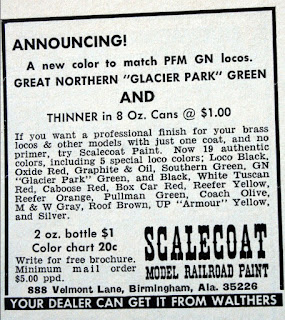At this point it looks like Scale Coat paint is defunct. It might be interesting to take a look at the product and see if we can assimilate enough information to develop something of an unofficial history. I've actually been working on this project for about a year.
This will be an ongoing series of posts written more or less as we go. Anyone who has additional information is welcome to respond; perhaps the story will become more accurate.

I started using Scale Coat I in the early 2000s when our home was in Denver a few minutes from Caboose Hobbies. They carried the Scale Coat line. Again, from experience in body and paint, I recognized that enamels were to be baked so I began baking the brass models in the kitchen oven; not an especially a good idea.
The ads called Scalecoat a revolutionary paint that did not need a primer; it could cover in one coat. This was very important to its durability and to the primary purpose for its "invention". Brass is a metal that challenges anything that is applied to it. Railroad models made with brass are typically very detailed - especially parts that are etched. Every layer of paint can hide more of this detail.
But the real power of the paint was that one ultra thin coat was flexible and durable. A single layer of Scalecoat - especially if it is baked is very difficult to damage. I've had clients tell me they tried to strip my paint jobs and found it
to be a strenuous job. I believe this is because of the paint's covering power and the "snapping" feature of the paint that when baked caused it to hug the surface. This would eventually happen without baking however because the actual process involved is the polymerization of the enamel binder into a plastic like skin. The binder oxidized.from a liquid to a solid.
I've heard that it was actually developed from the paint that the United States Navy used on its vessels. Being a Navy veteran I can believe that; Haze Grey was applied to every thing that didn't move and it was tough stuff. It had to be. Unfortunately I never had occasion to bake it. Wherever Scalecoat came from it could be summed up as advertised in the old magazines. Obviously the manufacturer achieved this remarkable performance by starting with a quality synthetic enamel binder that was less viscus, more heat tolerant and generously colored with pigments that were ground very fine and equally heat tolerant. I have had metal temperatures as high as 400 degrees-f with no effect on the paint.
Labels from the 1980 indicate the volatile organic compounds (V.O.C.) in Scalecoat was 58% which means the pigment and binder made up the other 42% of the mix. I had heard that the paint could be airbrushed straight from the bottle and I tried that a few times. It could be done many years ago but I've never tried it with later productions of the product. With the scarcity of the paint I would recommend thinning with straight Xylene even over the last manufacturers thinner. The recommended ration of thinner to paint is 1:2 in favor of the paint.There were additives to the paint that accelerated drying time but these
are still unknown to me. The Flat clear and Loco Black probably used
Bees Wax as a flattening agent.
I'll emphasize again that this is purely from my own research and not an
official History. I used magazine advertisements, the Weaver Models
History page on their website as well as the Walthers catalogs and a
site I highly recommend no matter what scale you model, HO Seeker, as
sources.
When the product first appeared on the market the volatile was a combination of Xylene and Toluene. This changed to only Xylene; probably in the late 1970s as the "greenies" began expanding their anti lead campaign into all things too nasty for even big boys to play with. Into the '80s only Xylene was listed on the label but in 1988 Federal Law required the label to include the ASTM D4236 assurance that the manufacture was responsibly warning of those nasties. How ever we may feel about such markings they can help us date the paint and draw understanding of its history.
In the beginning most of the colors were gloss but their excellent Loco Black 1 (S-1, S-1001) along with oxide Red and Graphite were matte. Later nearly all colors were gloss with only the Loco Black remaining matte. At the end of product Minute Man Scale Models added many flat colors.
By 1970 Iron Horse Models had nearly doubled the catalog of color as well as a flat and glossy clear coat. There was never a satin or semi gloss clear until Minute Man Scale Models acquired the line.
In November of 1967 the name of the product was changed to Scalecoat (spelling per ad) though the company name remained "Iron Horse Models" (not to be confused with PSC Iron Horse Models). From that point until December 1969 (so far as we are able to find) the paint was always sold by Iron Horse in Alabama. After Dec. 1969 Iron Horse Models disappeared.
As near as we can tell, Quality Craft Models (QCM) was established in May or June 1965. Their official history (online) establishes as fact that the Weavers started QCM in 1965. In the June 1966 Model Railroader (MR) the company announces its first anniversary with a big sale. At that time their address was a P.O. box in Villa Vista, Pennsylvania.
When we continue this discussion we'll see a transition in ownership and start examining the line, how it expanded and some of the changes that occurred.






No comments:
Post a Comment